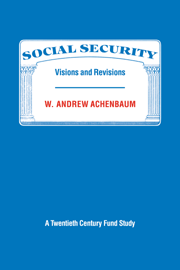Book contents
- Frontmatter
- Contents
- Dedication
- Foreword
- Acknowledgments
- Introduction
- Part I Social security comes of age
- Part II Current social security issues in historical perspective
- 5 Retirement under social security
- 6 Social security and the modern American woman
- 7 Universal coverage: an either/or proposition?
- 8 Federal health care programs and social security
- 9 A vision renewed: individual needs and mutual responsibility
- Notes
- Index
5 - Retirement under social security
Published online by Cambridge University Press: 04 August 2010
- Frontmatter
- Contents
- Dedication
- Foreword
- Acknowledgments
- Introduction
- Part I Social security comes of age
- Part II Current social security issues in historical perspective
- 5 Retirement under social security
- 6 Social security and the modern American woman
- 7 Universal coverage: an either/or proposition?
- 8 Federal health care programs and social security
- 9 A vision renewed: individual needs and mutual responsibility
- Notes
- Index
Summary
In 1983, Congress changed social security's “normal” retirement age in order to save the system itself. After considerable debate and by close margins, lawmakers raised the eligibility age for full benefits from sixty-five to sixty-six gradually by 2009, and then to sixty-seven by 2027. People could still take early retirement at age sixty-two, but with larger reductions in their social security benefits. Two changes in the retirement earnings test were also approved. Starting in 1990, beneficiaries between the ages of sixty-five and sixty-nine would have their benefits reduced by only $1 for every $3 (not $2, as under the present law) they earned over prescribed limits. Higher credits for delayed retirement would commence in 1990, rising from the current 3 percent per year to 8 percent for those who attain the normal retirement age in 2008.
These changes were considered enough to eliminate one-third of social security's projected long-term deficit. Even the higher benefits for workers who postponed their retirement were expected to cost little, or possibly result in some savings. For if healthy and productive workers could be induced to stay in the labor force past the official retirement age, social security's trust funds would accumulate more revenue than anticipated, because fewer workers would be drawing on current reserves.
The retirement provisions of the 1983 amendments conform to the pattern of incremental policymaking that has long served social security.
- Type
- Chapter
- Information
- Social SecurityVisions and Revisions: A Twentieth Century Fund Study, pp. 103 - 123Publisher: Cambridge University PressPrint publication year: 1986



